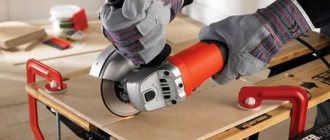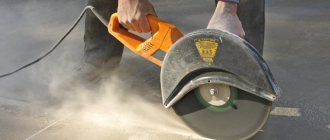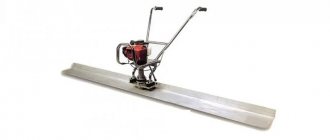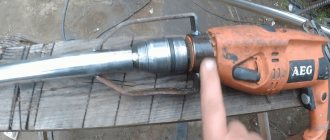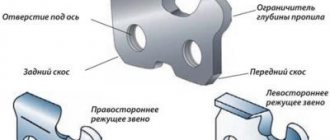During the construction process, there is often a need to drill holes in a concrete wall to change or create openings for doors, windows or communications. For these purposes, concrete is cut using a variety of equipment, from hand tools to heavy professional machines.
However, it is worth considering that drilling walls involves a huge amount of dust and noise. Therefore, before starting work, we will consider methods for cutting monolithic surfaces.
Concrete cutting methods
Concrete cutting involves chipping, drilling, crushing and grinding. According to the method of performing work, there are two methods:
- Dry. In this case, work is carried out with breaks, which are necessary for the equipment to cool down. In addition, when dry cutting concrete walls, you will have to use a special vacuum cleaner or wait until the dust settles (due to the volume of dust, you simply will not see the cut site). Another disadvantage of this method is the small depth to which the cutting apparatus can be immersed. Due to strong lateral friction, the disc will become very hot and fail faster.
- Wet. This dust-free cutting method is considered the most correct and less labor-intensive, since you do not have to wait for the equipment to cool down. The water supplied to the cutting wheel performs several functions at once: it cools the cutting tool and “beats” dust.
To produce high-quality and fast cutting of concrete without dust, it is recommended to use the wet processing method. To perform this type of work, various diamond-coated tools are used.
Summary
Let us briefly repeat which cutting method to use for certain purposes:
- Wall sawing machine - making openings, separating thick vertical structures;
- Rolled cutting - cutting of individual structures that can be covered with a rope with an abrasive, for dismantling work;
- The seam cutter is used in road construction and for processing horizontal concrete surfaces;
- The diamond drilling unit is designed for drilling holes in walls and ceilings;
- Water and laser beams are used in extreme cases to treat concrete. The laser can also be used for sawing horizontal and vertical structures.
Let us repeat: the choice of equipment is influenced by the age of the concrete, composition and quality. By combining all the selection factors into a single whole and analyzing the situation, you can easily select the right tool.
- Wall kit
Tools
Today, cutting openings in concrete is carried out using the following units:
Hand carvers
Such equipment for cutting concrete is most often called a “grinder”, but in the professional sphere this device is called an angle grinder (angle grinder). This manual cutter allows you to make openings up to 13 cm thick in the wall. Tools of this type can have different powers, and they are also equipped with special attachments that are fixed to the grinder using a screw thread. Most often, cutting is performed using grinding, roughing and cutting diamond discs.
Healthy! When choosing diamond cutting discs, it is recommended to buy products with cutouts for ordinary concrete and without cutouts if you plan to cut reinforced concrete structures, since the protruding elements of the disc will cling to the reinforcement.
Hand cutters have high maneuverability, thanks to which work is carried out in large volumes. On the other hand, grinders and diamond discs for concrete are suitable only for small areas. If you use such equipment for large construction projects, you or your workers will quickly get tired.
Wall sawing machines
A wall saw is another concrete cutting tool that is equipped with a diamond blade. The unit consists of a motor, a hydraulic pump station, guide rails (for vertical and horizontal fixation), a cutting disk (with a diameter of more than 25 cm) and a control panel.
This type of machine provides higher cutting quality. In addition, the unit has the following advantages:
- The depth of the opening can reach up to 7.5 cm.
- Suitable for voluminous work of increased complexity.
- With the help of the unit, reinforced concrete is cut as quickly as possible.
- Low noise and vibration levels.
- Reliable fixation on the surface being treated.
Among the minuses it is worth highlighting:
- High cost of concrete cutting machine.
- To use the unit you must undergo training.
- Requires 380 W power supply.
Seam cutters (seam cutters)
Seam cutters are often used to cut horizontal concrete floor slabs and create expansion joints and openings. The joint cutter consists of a metal frame on wheels, an engine and a cutting wheel. Using this equipment, openings up to 2.7 cm deep can be cut.
There are seam cutters:
- Stationary. Devices of this type are used for thick layers of monolith.
- Portable. Such units allow you to make cuts of different depths and configurations.
Among the advantages of this equipment is the ability to cut thick surfaces with minimal vibration. Among the disadvantages, it is worth highlighting the high cost and the ability to process exclusively horizontal surfaces.
Rope machines (cutter)
Rope machines are available with both hydraulic and electric drives. Also, devices of this type are equipped with oil stations, rope racks, rollers and cooling systems.
Rope cutting of concrete is used for dismantling large buildings (bridges, piers, columns and much more). Such a specialized cutter is capable of making holes up to 50 cm deep. Cuts are made in any direction.
The main cutting element in such machines is a special rope coated with diamond coating.
This type of equipment is considered expensive and difficult to operate, so rope machines are used for various jobs (dismantling, cutting reinforced concrete, blocks and pipes) on large construction sites.
However, making cuts with a grinder or wall saws is not always possible due to the lack of electricity. In this case, a concrete chainsaw or, as it is also called, a gas cutter, is used.
Concrete cutting saws
For manual cutting of concrete, a concrete chain saw powered by gasoline or compressed air is often used. This lightweight and affordable tool does not require any special skills, so it is ideal for DIY construction work.
A chain cutter differs from a chainsaw for wood in that it has a more complex bar, which is equipped with special channels for water supply (due to which concrete is cut without dust) and a diamond chain.
This cutting set allows you to make cuts up to 30-40 cm deep, while the unit rotates 90 degrees, which is very convenient when creating niches, openings and other holes in concrete.
As a rule, gas cutters operate on a push-pull principle and are characterized by a high degree of protection against dust formation.
The concrete cutting saw is suitable for the following materials:
- Lightweight concrete (expanded clay concrete, wood concrete and other materials).
- Heavy concrete, which includes Portland cement, asphalt and other binders. You can also use a gas cutter to process monoliths if there is a weak reinforced frame.
- Silicate and ceramic bricks.
- Natural stones, porcelain stoneware and other artificial materials.
- Gypsum, plasterboard and limestone structures.
The gas cutter is also suitable for working on foam concrete and other cellular concrete (foam blocks, gas blocks, foam-gas concrete blocks and others).
Also today there is:
- Laser cutting of concrete. The treatment is carried out by heating the surface with a laser. Due to the high cost of equipment, such processing is now practically not used.
- Plasma cutting of concrete. This method is also never used in private construction, but the cost of the equipment is lower. For plasma cutting, the material is also heated, but not by the laser, but by the compressed plasma arc.
Once you have decided how to cut concrete, you need to take into account several nuances of the work.
Decor of concrete stone
If you need to decorate concrete, how to cut it? There are 2 technological types of equipment:
- Water cutting is carried out by a machine that supplies a stream of water with (or without) abrasive under high pressure. The result is an even contour of the given pattern. The method is used on computer-controlled automated machines.
- Laser gas-discharge installations are rarely used due to their high cost and relatively recent appearance. Today, it is used to make decorative stone elements for various purposes. In general, a laser is capable of cutting any volume of concrete, but due to the high cost of the process, the method is used only in cases of extreme necessity.
Features and procedure for cutting concrete
Before cutting concrete, you need to determine the type of building material, especially if you are using an angle grinder with a disc. Therefore, first check the thickness of the surface to be treated. If the cutting depth is about 10 cm or more, then the diamond wheel for concrete will most likely bump into the reinforcement, so you need to choose more durable cutting discs.
Also consider the following recommendations:
- Basalt and quartz quickly dull the disk.
- The larger the fraction of filler in the concrete slab, the slower the cutting will be.
- The smaller the hand cutting tool, the less power it will have.
- For fresh and hard material, you need to use different concrete cutting discs.
- Before starting work, it is necessary to make a test cut, no more than 1 cm deep. This is necessary in order to evaluate the operation of the equipment.
- When performing dry cutting, remove the blade from the unit between cuts to cool it faster.
- When using any equipment, be sure to wear a protective respirator mask, goggles and gloves.
- For perfectly smooth, round holes in concrete, use special diamond core bits.
After preparing and checking your equipment, follow these simple steps:
- Mark the line along which the cut will be made. To make your work easier, secure wooden blocks along the cutting line. Thanks to this, the disk or saw will not “carry” from side to side and you will not accidentally make a cut deeper than necessary.
- Turn on the equipment and make a test cut.
- Continue working, immersing the equipment to the desired depth (remove the bars).
How to cut?
To destroy large objects, hydraulic shears are used, which are attached to the boom of a crane. Dismantling is carried out without shock vibrations, which ensures the compressive ability of the cutters.
Choosing a tool is an important process when cutting concrete, so study the object before doing so. The thickness of the wall, access to electricity and water play an important role. To cut concrete with a grinder, follow these recommendations correctly:
- A large fraction of concrete filler slows down cutting.
- Small units also have low power, so they are not used for complex tasks.
- The choice of disc also depends on the age of the concrete.
- When performing repairs, wear a protective mask and gloves.
- Concrete cutting without noise and dust is carried out using wet cutting units.
- To speed up the cooling of the disk during a break, it is recommended to remove it.
Chemicals
Chemicals that allow the dismantling of concrete structures include:
- Mixtures with high acidity, which dissolve concrete in a limited time, violate its integrity and provide the ability to remove bricks and concrete residues. The basis of acid compositions is concentrated hydrochloric acid and special inhibitors that penetrate deeply into the massif, expanding it. The use of acidic compounds requires the mandatory use of protective equipment for operating personnel.
- Special-purpose powders with an increased expansion coefficient, which are used to fill pre-prepared holes. Implementation of the process requires significant financial costs, but allows you to achieve the required result within 24 hours, using a minimum amount of labor.
Chemicals are used to destroy durable building materials, since their use prevents fires and explosions
Cutting tiles
Sometimes it becomes necessary to shorten a standard concrete slab at home without having power tools.
Here you will have to work manually. For this:
- mark a line with a pencil on both sides;
- split concrete with a scarpel and a hammer;
- A chisel and a hacksaw will help you deal with the reinforcement.
With this method, on one side the edge turns out to be uneven. This end is laid against the wall, and subsequently it is covered with a plinth.
Using an acidic mixture
Experts know how to destroy concrete without physical effort, and what substance has a detrimental effect on it. Based on this, an acid mixture, which is a material, is often used to dismantle durable reinforced concrete structures.
To remove a small amount of a hard substance from the surface, it is enough to apply a substance on top of it, for example, hydrochloric acid.
In most cases, acid is used very rarely in its pure form; a special mixture is prepared for this purpose.
With its help you can:
- dissolve concrete;
- remove it from bricks;
- wash off the residue from the wall.
The mixture contains concentrated acids and inhibitors. The latter are needed to protect other surfaces when processing concrete. For example, if you need to clean a frozen concrete mixer. The mixture will quickly penetrate deep into the material and destroy it; as a result, after some time it will turn into dust, which can be easily swept away with a simple brush.
Electric jigsaw
Craftsmen know this type of jigsaw as a reciprocating saw. This saw is used in the construction of medium and large objects.
You can change the blades on a jigsaw (put discs with different tooth sizes, change dull or damaged discs; the shape of the teeth on the discs can also be different - large and small teeth).
As a rule, for the convenience of builders, many saw models are available with replaceable batteries so as not to be tied to a power source.
When working with this type of tool, you must remember that sawing wet material is not permissible, as this may result in injury. The saw will “chew” the crumbs and may injure the builder.
Before starting work, it is better to try on the tool. Play through the saw movements without the power on.
You need to cut with the middle part of the saw; the length of the working cutting surface should be approximately 25 centimeters.
To avoid injury, you should hold the saw firmly in your hands.
Chemicals
Chemicals that allow the dismantling of concrete structures include:
- Mixtures with high acidity, which dissolve concrete in a limited time, violate its integrity and provide the ability to remove bricks and concrete residues. The basis of acid compositions is concentrated hydrochloric acid and special inhibitors that penetrate deeply into the massif, expanding it. The use of acidic compounds requires the mandatory use of protective equipment for operating personnel.
- Special-purpose powders with an increased expansion coefficient, which are used to fill pre-prepared holes. Implementation of the process requires significant financial costs, but allows you to achieve the required result within 24 hours, using a minimum amount of labor.
Chemicals are used to destroy durable building materials, since their use prevents fires and explosions
It is important to know
Modern manufacturers offer a variety of equipment models, so finding a specific model of equipment in Moscow and the regions will not be difficult (as well as companies or specialists who will quickly and efficiently complete the work). But you need to remember some nuances.
Cutting concrete without dust is a difficult task, which can only be partially realized. It is very difficult to completely get rid of dust, but its amount can be significantly reduced through the correct choice of equipment and attachments, cutting method, as well as the use of a construction vacuum cleaner and the creation of special devices for collecting dust.
Source
Basics of processing aerated concrete blocks with saws
Craftsmen who have more experience with construction electrical equipment and fixtures, as well as the need to work with them more often, prefer to cut aerated concrete bricks with an electric reciprocating saw or alligator saw rather than with hand tools. But with a one-time use of aerated concrete (for example, when constructing an outbuilding, garage or country house - you don’t need several of them on one site), a hand saw for aerated concrete will be more economical and reliable.
An electric reciprocating saw for aerated concrete is a powerful jigsaw that imparts a horizontal reciprocating motion to the saber-shaped cutting blade. There are saws with two blades, and many models are battery-powered. Reciprocating saw blades are sold with teeth of different sizes and shapes. The alligator saw works on the principle of a crankshaft - the rotation of the electric motor rotor turns into reciprocating movements of two cutting blades. The blades move in opposite directions, but in a horizontal plane, so the cutting edge is always clean and even. The price of such a power tool is much higher than that of a reciprocating saw, and an alligator saw will pay off only with constant use, that is, in professional construction. Therefore, before such a highly specialized purchase, think about where this tool will work after construction is completed. A hand saw with carbide (pobedite) tipped teeth lasts much longer than a regular hand saw, which has to be sharpened after several cuts. You can build a house using pobedit tips without replacing the saw, and it will still serve
When choosing such a tool, it is recommended to pay attention to the thickness of the blade - a thin saw will be pulled to the side, the cut will be uneven and inclined. A saw with a thick blade makes precise, neat and even cuts.
Therefore, when choosing what to cut aerated concrete with, pay attention to the accuracy and reliability of the tool, and not to its price: many people think that an expensive power tool is the key to successful construction, but this is not always the case. First try cutting the foam block with a regular hand saw, and only if the results are unsatisfactory, buy more expensive saws for aerated concrete
Using special equipment
At the construction site, the block is cut to fill the gaps between corners and technological openings. Do not hammer with a hammer drill under any circumstances, since as a result of numerous impacts, many cracks are formed inside the concrete, which reduce the bearing capacity of the foundation.
According to existing standards SP 22.13330 (Building foundations), SP 50-101 (design of foundations and foundations), as well as according to standard PPR work plans, only solid FBS are used in prefabricated strip foundations. The designer must prepare a layout diagram taking into account the dimensions of reinforced concrete products, as specified in GOST 13579. In reality, the need to split the block is 99%.
Today there is not a single tool or equipment for it that can cut a foundation block in one step or along the ring (a cut on each of the four sides).
Consequently, this technology for cutting foundation blocks is much more often used:
- Installing the block on a rigid base (another block laid on its side or a hollow-core road slab) using the standard slinging method using two mounting loops.
- Hooking the block in one loop and lifting it by 5-10 centimeters using a crane.
- Marking the required length of a piece of FBS on the body of a concrete product using a tape measure.
- Laying rolled metal in this place under the sole of the element to be split (corner edge up or steel scrap).
- Place the sling as close as possible to the edge of the foundation slab on the short side.
- When rising to a certain height, the sling breaks off from the body of the block, which falls from a small height and splits along the intended line.
The biggest problem with high quality blocks is the fact that splitting diagonally produces unpredictable results. Consequently, professionals sacrifice time to ensure precise cutting:
A more efficient way:
Using a sledgehammer, all accessible edges in the areas where the side surfaces meet (most often the top two) are knocked down.
Qualitative method:
Creating cuts to the full depth of the equipment using an angle grinder with a diamond blade on three available surfaces.
The second method ensures that the block is broken along a line that is perpendicular to its long part.
Alligator
The alligator-type saw is particularly durable and wear-resistant. The teeth of such a saw have special coatings made of pobedite, which makes the teeth more durable. This tool is used in the construction of large objects (apartment buildings, large offices).
The advantage of this tool is that it does not need to be constantly sharpened or blades changed, as, for example, in an electric jigsaw.
When purchasing such a saw, it is better to choose an option with a thick-walled blade, since only cutting with such a blade will give an even cut without chips or roughness.
It is often written that before starting to work with such a saw, you need to lubricate the surface with a special lubricant, but practice says otherwise. The lubricant mixes with dust, causing the saw to stop working.
Although the instructions for most tools of this type specify the use of lubricant. The absence of lubricant increases productivity significantly.
Thermal methods
Another budget method, the use of which does not require professional tools, is associated with alternating exposure of artificial stone to high and low temperatures. It cannot withstand their sudden change and begins to crack.
For heat treatment, you will need a blowtorch for heating and cold water for cooling. Due to the use of water, the method is not recommended for use if there are residential premises or electrical equipment under the object in which dismantling work is being carried out. But it is perfect for solving such a problem as breaking a concrete foundation.
First, the concrete is heated for a long time with a blowtorch, and when it gets hot, it is poured with ice water. The monolith is covered with deep cracks, along which it easily breaks when hit with a sledgehammer.
A cracked monolith is easier to destroy Source zabivniesvai.ru
In winter, instead of wedges, you can use ordinary water poured into the holes. Freezing in severe frosts, it will expand and destroy bonds in the thickness of the material.
